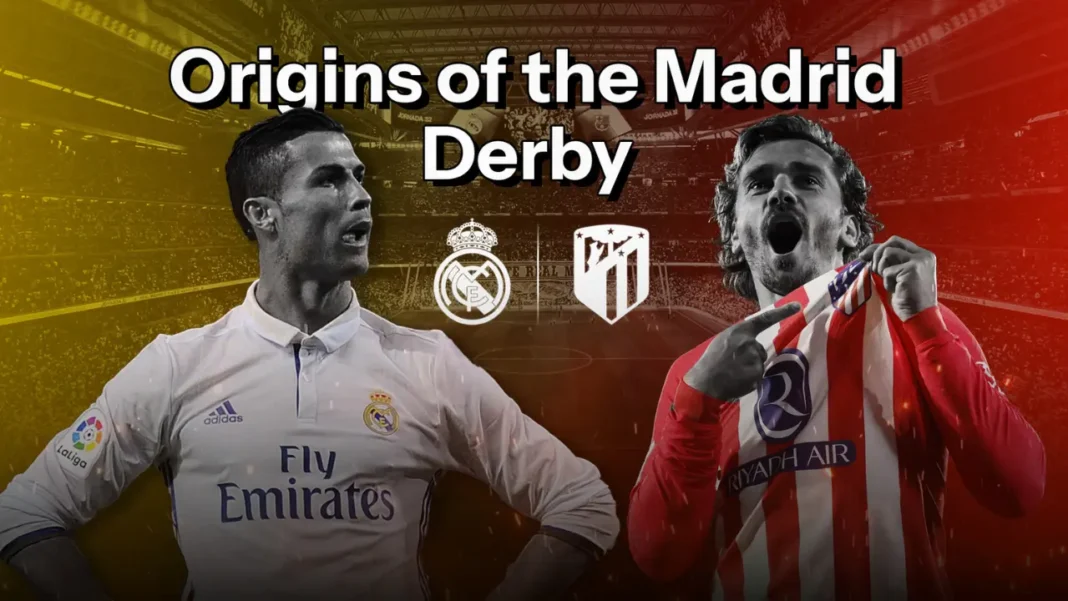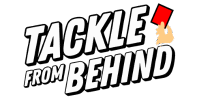Madrid, a city split by more than just footballing loyalties.
On one side stand the Galácticos of Real Madrid, the kings of Europe with their glittering white shirts and obsession with trophies. On the other hand, Atlético Madrid, the working-class warriors in red and white, built their identity on grit, defiance, and never backing down.
The Madrid Derby, ‘El Derbi Madrileño,’ isn’t just about points. It’s about power, pride, and two clubs whose history tells the story of Spanish football itself.
But how did this rivalry begin? And how did it evolve from a local feud into one of the world’s most-watched derbies? Let’s rewind.
The Origins of the Madrid Derby
A Basque Beginning
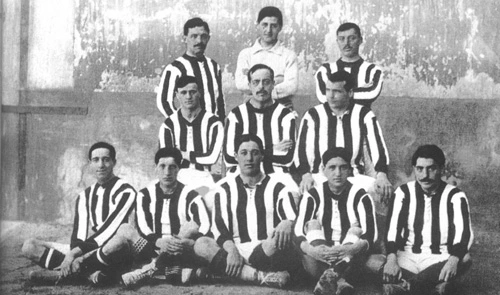
Atletico Madrid’s story actually starts with Athletic Bilbao. After Bilbao defeated Madrid FC in the 1903 Copa Del Rey Final, some Basque students decided to form a sister club in the capital: Athletic Club de Madrid.
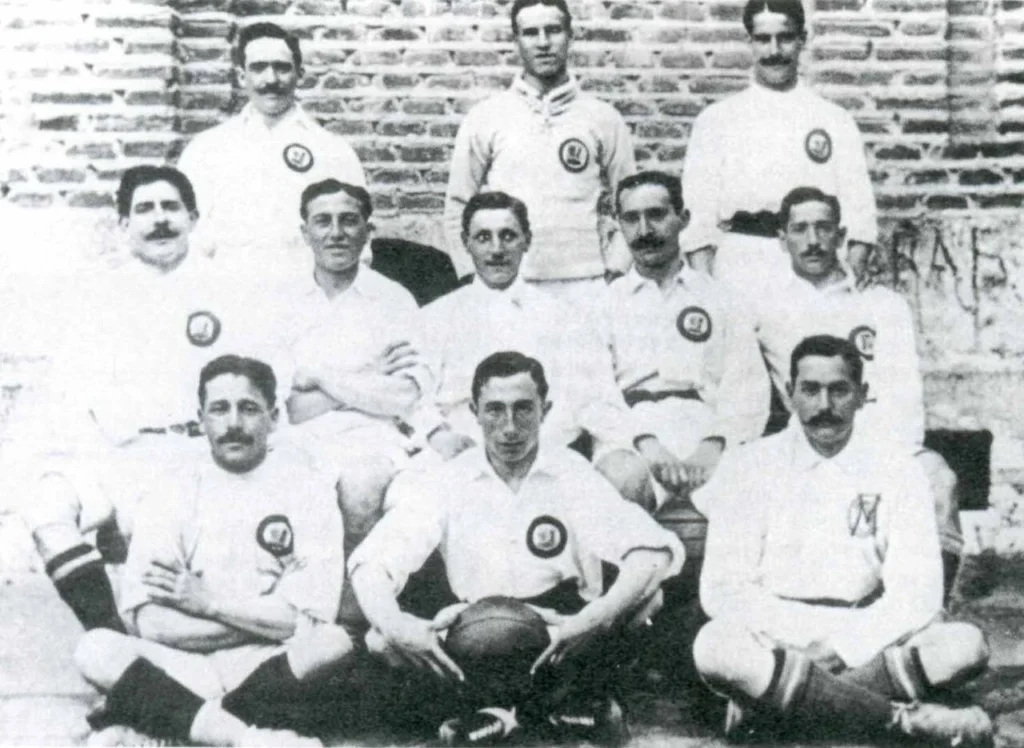
Meanwhile, Madrid Football Club (later Real Madrid) was already establishing itself as the city’s main football team, swallowing up smaller rivals along the way. Unlike others, Athletic Madrid couldn’t be absorbed. For the first time, Madrid FC had a true challenger in the capital.
By 1905, several ex-Madrid players defected to Athletic, strengthening its identity. The first official clash came that same year, a 1–1 draw. A rivalry was born.
First Sparks Fly
In the early decades, Real Madrid dominated headlines, while Atlético carved out a reputation as the scrappy underdog. By 1916, things had already turned fiery. The regional championship final between the two was abandoned after fans began brawling in the stands.
Before La Liga even existed, the rivalry already had teeth.
Post-Civil War: Atleti’s Rise
The Spanish Civil War (1936–39) devastated both clubs. Real Madrid’s stadium lay in ruins. Atlético lost eight players to the fighting.
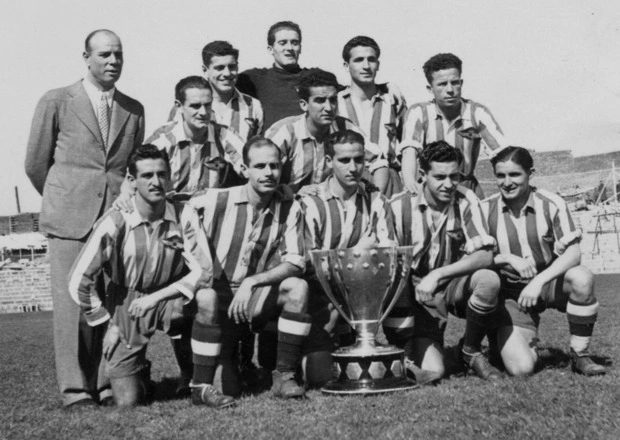
When football returned in 1939, Atlético were reborn through a merger with the Spanish Air Force team, becoming Atlético Aviación. With government backing, military connections, and access to resources, they surged. Under Ricardo Zamora, they won back-to-back league titles in 1940 and 1941.
Real Madrid, meanwhile, floundered through the 1940s. Even Santiago Bernabéu’s arrival as president in 1943 couldn’t immediately reverse their fortunes. To add insult, Atlético handed them their heaviest derby defeat of that era, a 5–0 win in 1947.
For a time, red-and-white ruled the capital.
The Golden Age:
Di Stéfano Changes Everything
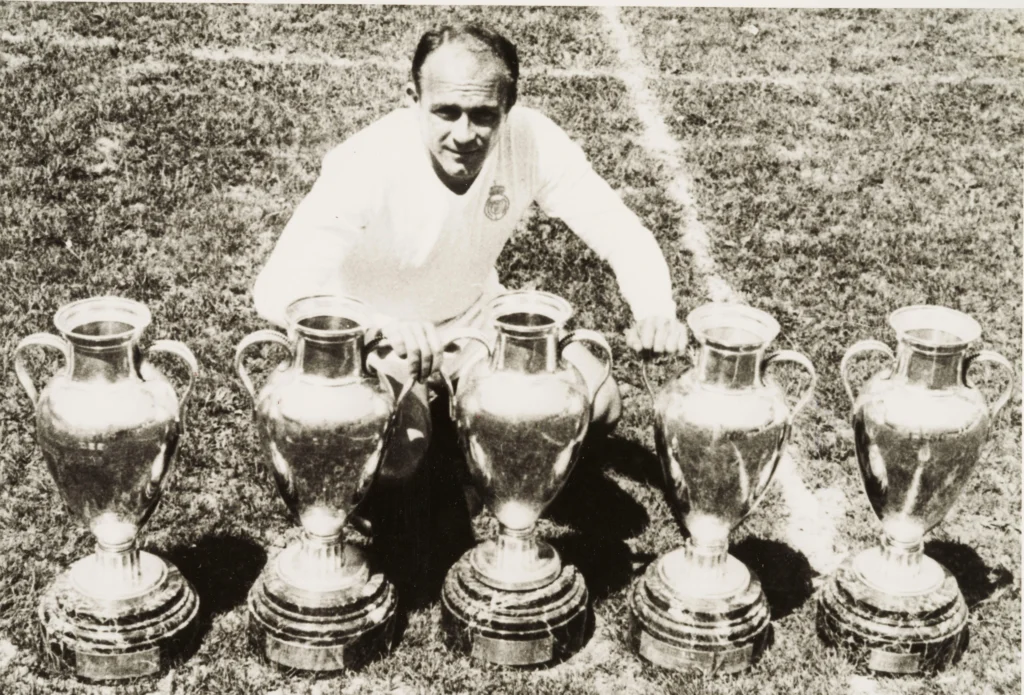
The 1950s changed the trajectory of Real Madrid forever. The arrival of Alfredo Di Stéfano in 1953 turned Los Blancos into a European juggernaut. League titles, five straight European Cups, and an aura of invincibility followed.
But this wasn’t just a one-horse race. For Atlético, the 1950s and 60s were their golden age too. They challenged Real’s dominance and often toppled them in key moments.
Derby Days of the 1960s
- 1959: The rivals met in the European Cup semi-finals. Atlético won the first leg 1–0 but Real rallied to force a replay and advanced. Ferenc Puskás later admitted: “Atlético were our great rivals.”
- 1960: The first ever Copa del Rey final between the two Atlético shocked Real 3–1.
- 1961: A year later, they repeated the feat, beating Real again in the Copa final.
Real may have taken eight league titles in the 1960s, but Atlético grabbed the other two, ending Madrid’s five-in-a-row streak in 1966. For many Madridistas of that generation, Atlético, not Barcelona, were the true rival.
Identity, Nicknames, and Celebrations
The 1970s cemented not only the footballing rivalry but also the cultural divide between the two.
Real Madrid, nicknamed Los Vikingos, were portrayed as an army of tall, blond imports plundering Europe’s trophies. Atlético, in response, became Los Indios because of their South American-heavy squad, their stadium by the river Manzanares, and their rebellious spirit under president Jesús Gil.
And then came the battle of the fountains.
Few people know this, but it was actually Atlético Madrid who first celebrated their trophies at Madrid’s Cibeles Fountain. For Atleti, it was the perfect city landmark to gather around. But as the decades rolled on, Real Madrid kept winning, and winning, and winning. The Cibeles became synonymous with Los Blancos — draped in white scarves and flags every time another title came home.
Eventually, Atlético abandoned the Cibeles and made the Neptune Fountain their own. To this day, Cibeles belongs to Real and Neptune belongs to Atleti, another way the city stays divided.
Between them, they shared eight league titles in the decade (six for Real, two for Atleti). In 1980, the Calderón hosted a Copa del Rey final between the two Atlético triumphed on penalties. For the Rojiblancos, it was sweet revenge on home turf.
The nicknames stuck. Vikingos vs. Indios. Cibeles vs. Neptuno. This wasn’t just about football; it was about identity.
The Players Who Crossed the Divide
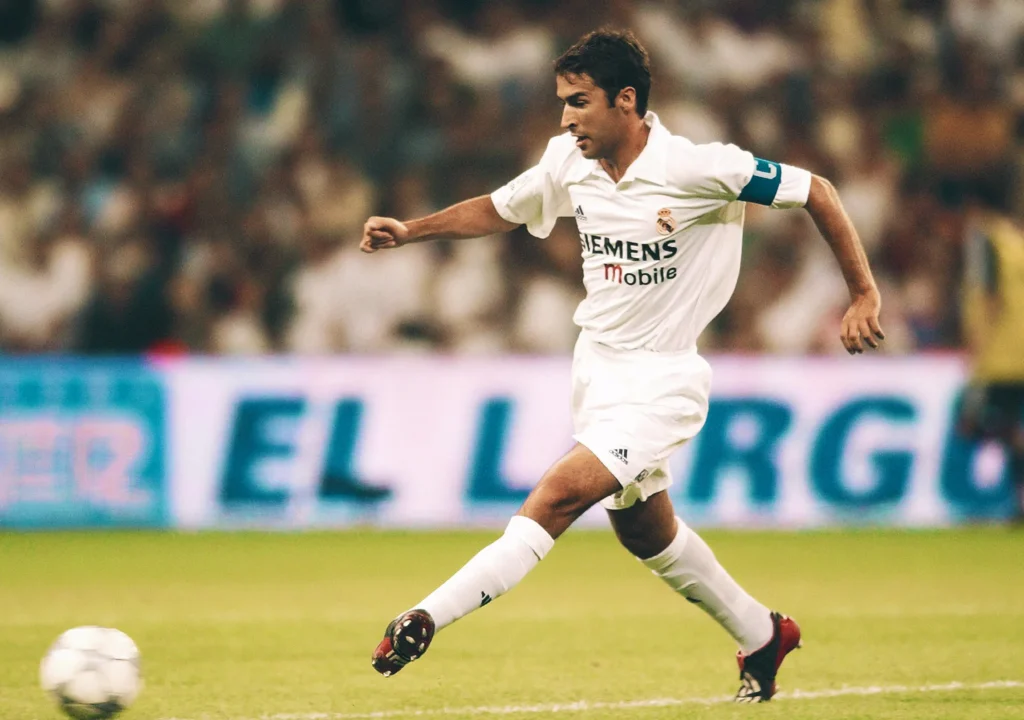
Few things anger fans more than betrayal. And the Madrid Derby has had plenty of “traitors.”
- Hugo Sánchez– A Pichichi winner at Atlético before crossing the divide in 1985 and becoming a Real Madrid icon.
- Raúl González– His family were die-hard Atleti fans, and he started in their youth academy. But when Jesús Gil shut it down, Raúl moved across and became Real’s legendary No.7.
- Juanito– Another Atlético youth product who found glory in white.
- Luis Aragonés– Perhaps the most famous rojiblanco of all time, ironically began at Real Madrid before becoming Atleti’s greatest player and later coach.
Every switch added spice to the rivalry. For fans, these weren’t just transfers; they were scars.
The Revival
The 1990s should have been Atlético’s time. They won a famous Copa del Rey final over Real in 1992 and secured a league and cup double in 1996. But chaos soon returned. By 2000, they were relegated, a humiliation that cut deep.
Real Madrid, meanwhile, were flying. The Galácticos era brought Figo, Zidane, Ronaldo, and Beckham. On the pitch, they crushed Atlético repeatedly, going on a 23-match unbeaten run in derbies.
For over a decade, the derby lost its balance. To many younger fans, it barely felt like a rivalry anymore.
Simeone’s Revolution: A Derby Reborn
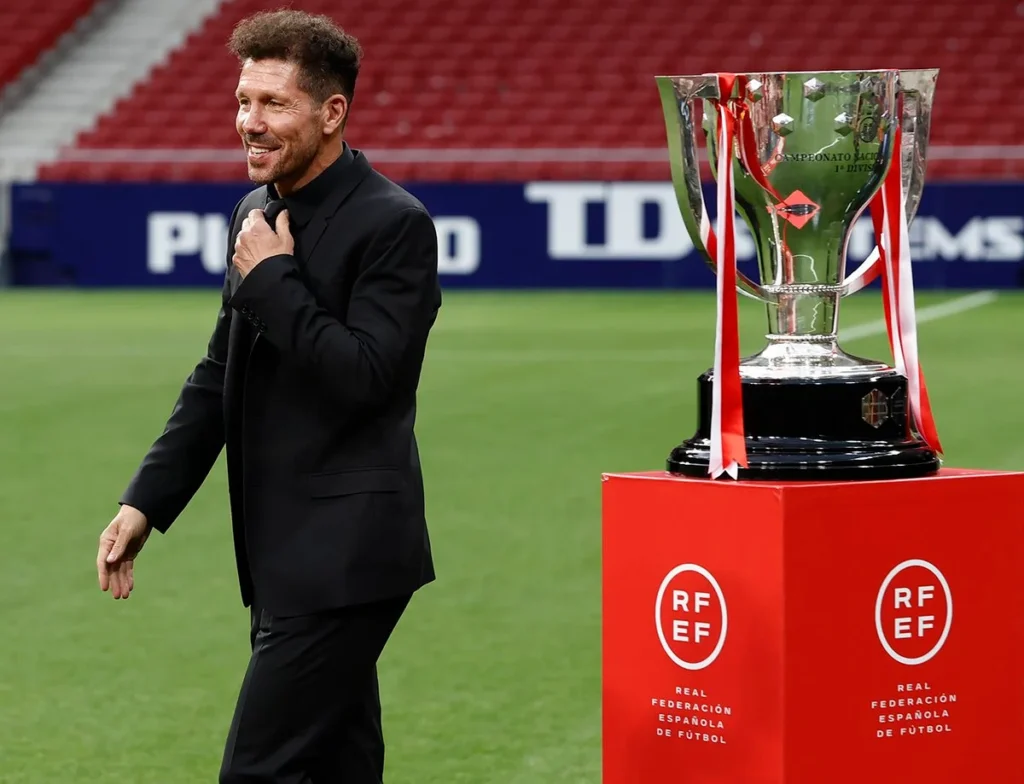
Everything changed in December 2011, when Diego Simeone took charge of Atlético Madrid.
The Argentine rebuilt the club in his own image: disciplined, relentless, fearless. Within three years, Atleti had broken Real’s monopoly, winning La Liga in 2014 at the Camp Nou. They even reached two Champions League finals, both against Real.
The 2014 final in Lisbon was pure drama. Atlético led until the 93rd minute, only for Sergio Ramos to equalize. Real went on to win 4–1 in extra time. Two years later in Milan, penalties decided it again, Real triumphant once more.
For Atlético fans, these losses weren’t just defeats. They felt like destiny. That’s why many rojiblancos call themselves “El Pupas” the cursed ones. It’s a phrase that sums up decades of near misses, heartbreaks, and cruel twists of fate, none harsher than losing two European finals to their own city rivals.
Those defeats hurt Atleti deeply, but they also reignited the derby. For the first time in decades, both clubs were competing at Europe’s highest level.
The Madrid Derby Today
Now, the Madrid Derby is back among Europe’s must-watch fixtures. Whether it’s La Liga, the Copa, or the Champions League, meetings between Real and Atleti carry weight.
- Real Madrid still dominates in overall silverware and global reach.
- Atlético, under Simeone, remains Europe’s toughest fighters, never glamorous, but never easy to beat.
- Recent derbies have given us unforgettable moments: Late winners, Penalty controversies, red cards, Thibaut Courtois’ saves, and Jan Oblak’s heroics.
The balance may always lean towards Real in terms of trophies, but in spirit and fight, Atlético ensure the derby is never one-sided.
FAQs
Q: When was the first Madrid Derby played?
The first official match between Real Madrid and Atlético Madrid took place in 1905 and ended 1–1.
Q: Why is it called “El Derbi Madrileño”?
Because both clubs are based in Madrid, it’s the city’s derby, though fans around the world follow it closely.
Q: Who has won more Madrid Derbies?
As of 2025, Real Madrid leads the overall head-to-head winning 117 Derbies, with more than double the number of La Liga titles and European Cups compared to Atlético.
Q: Where can you watch Atletico Madrid vs Real Madrid?
Fans in India can watch the Madrid derby live on Fancode.
Conclusion
The Madrid Derby is more than just a football match. It’s the story of a city split in two kings in white versus rebels in red and white.
From Di Stéfano to Simeone, from Puskás to Griezmann, from Bernabéu to the Calderón, and now the Metropolitano, every generation has written its own chapter.
For Real fans, it’s about keeping their crown. For Atleti fans, it’s about proving that defiance can topple royalty.
And for the rest of us? It’s a reminder of why football rivalries matter: because they’re never just about the game.
Madrid may be one city. But on derby day, it feels like two worlds colliding.

